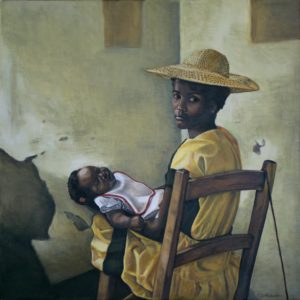

Why Giving Your Artwork a Title is a Good Idea
Do you title your artwork?
A reasonable rationale for leaving works untitled, is that viewers are free to interpret the piece based on anywhere their fantasy takes them. In support of this position, I can acknowledge that I have occasionally been quite impressed with the eloquent response a viewer has expressed to one of my paintings and wish I had had such a profound intention when I painted the piece! Even so, personally, I’m put off by seeing that a work of art is “Untitled”. I register that as a failure of imagination. Yet, once I had the experience of being delighted with a painting, and then, after reading the title, I felt somewhat deflated; turned off by the pedestrian, truly ho-hum sentiment that the title expressed. I had seen more in the painting.

Although there may be reasons for leaving works untitled, there are serious advantages to coming up with a good title (whatever that means; we’ll discuss it later). According to an article by Alan Bamberger on ArtBusiness.com, “a title always adds value to a work of art”. I can share a bit of experimental evidence that supports this idea. I used to teach classes in Research Methods. One of my college students was an artist who wanted to do his research project on a topic relevant to the art world. He came up with a small piece of contemporary art that largely consisted of a red and green background, with hints of a nose and lips outlined in black. There were three experimental conditions, each of which included showing subjects the same painting, in-the-flesh so-to-speak. Each group of students was shown the painting and told a few things about it. In the first condition, the painting was titled “No. 3 in Series B”. In the second condition, the title was “Luscious Lips,” and in the third condition, the title was “Lying Lips”. The students were asked five questions that involved their responses to the painting and their speculations about it, such as what the price of the painting might be. None of the responses across the three conditions were significant, except that students in the “Lying Lips” group thought the painting would sell for twice as much as did the students in either the “No. 3 in Series B” or the “Luscious Lips” groups. Now that’s something to ponder when you are thinking up a title!
A title gives viewers more information than they would have if the work were to remain untitled. Titles serve as introductions to your art and provide viewers a glimpse of you as an artist. They may have come across your work by chance, liked what they saw, and become curious about you. Intriguing titles give prospective customers a reason to look further at your body of work. Strong titles reflect what inspires you to make art, what personal beliefs you have that it represents, what message it is meant to communicate, and why the viewer should look at and think about it.
A major advantage to titling your work is that people searching the Internet on a specific topic will be able to find it. Untitled art is not searchable. The more opportunities you give people to discover your art, the better. The term “untitled” fails to distinguish one piece of artwork from another.
How to Title Your Art
Artists often wonder how to come up with good titles. There is no denying that giving your work an advantageous title is a tricky business. Let’s explore 10 factors that make a title add something to your piece. What follows are some basic guidelines for how to title your art (These tips are substantially reformulated from an article by Alan Bamberger on ArtBusiness.com):
1. Think of titles as being keywords in a computer search. What are the most important words that describe your artwork? What kinds of words do you use when talking about that piece? These words are useful starting points for excellent titles.
2. Choose titles that make your art more accessible by hinting at what it is about. Many people don’t like trying to figure out the meaning of artwork. A title gives them a clue as to your intention in creating the masterpiece, as well as a reason to pause and take a closer look.
3. Consider using titles that provide specific information about the piece. Many people are too embarrassed to ask what untitled art is about, even if they like it. Titles at least give viewers a fighting chance to understand what they’re looking at.
4. If possible, use titles that have some connection to the visual content or composition of the work as opposed to ones that are completely unrelated to what the art looks like. If a composition has identifiable geographical locations through landmarks, species of plants, animals, people, or objects, you’ll want to consider including those names in your title. That way, your art might come up in search results for those proper names. For example, someone searching for information about the California wineries might find your painting in their search results, and like it so much that they decide to view more of your art, or contact you about purchasing the piece.
5. Good titles help people to recognize and appreciate aspects of your art that may not be immediately obvious. For instance, a figure painting might be about family members or childhood memories. Without a title, viewers would not get the chance to fully experience those aspects of the work that inspired you to create it. Titles help viewers see what you want them to see. For example, even though I often use friends and family members as models, I usually don’t name my relationship to the person in my title, because I want the viewer to focus on the universal experience of joy a child has in splashing around in a water fountain or a young girl has in going on a walk with her mother. This is what I want them to see.
6. Cryptic titles that do not instantly relate to the composition or subject matter of your art can intrigue the viewers and prompt them to linger a bit longer in front of your artwork, puzzling over the riddle you have supplied to them. Such titles seduce viewers into taking longer looks, and maybe even asking questions if the artist happens to be available. Unexpected or uncommon titles engage viewers in ways that ordinary titles do not. Be careful, though. Titles that baffle the viewers may also annoy them. Allow them to “get” what your title means within a brief span of time. A famous example of a cryptic title is Rene Magritte’s painting of a pipe. The title is “The Treachery of Images,” but the sentence in the painting (translated into English) is: “This is not a Pipe” (Instead, it’s a realistic painting of a pipe.)
7. Unusual words or phrases tend to attract more interest and attention than common ones. These kinds of titles also have better chances of appearing higher up in search results because of their uniqueness. Be sure that your unusual words relate directly to your art, and do not use them gratuitously or to try and game the system.
8. Your title for each piece should be different. Not only do viewers appreciate unique titles, but also an array of titles by the same artist, when taken together, can offer the viewer insight into the artist’s perspective, and thus help people connect with the artist’s purpose in producing the work. Having a different title for each piece of your art also maximizes the number of opportunities for your overall body of work to appear in search results.
9. Gallery owners really like titles, particularly ones that increase viewers’ interest in the art. Plus, explanatory titles make their job easier when it comes to selling your work. For instance, my landscape painting titles name the exact location, because I realize that the first thing I want to know when I see another artist’s landscape painting is where it was painted. As with artists who have websites, galleries need to list individual works online, in emails, or on price lists, so unique titles avoid confusion.
10. Avoid numerical titles. Not only do they provide little or no information about the art, but also they can’t be searched. Similarly, don’t use the same title over and over again followed by letters or numbers to distinguish one work from the next, like Urban Landscape 1, Urban Landscape 2, Urban Landscape 3, and so on. Doing this limits people’s ability to find your art.




